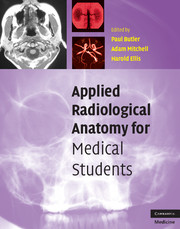13 - The lower limb
Published online by Cambridge University Press: 12 November 2009
Summary
Imaging methods
The bony pelvis and lower limb are increasingly examined using the full armoury of imaging modalities as these become more widely available.
Plain radiography
Plain radiography remains as important as ever, and its more detailed applications will be discussed further in the relevant anatomical subsections.
Computed tomography (CT)
CT is especially useful in complex skeletal trauma, using three-dimensional reconstructions to contribute valuable additional information.
Magnetic resonance imaging (MRI)
MRI has revolutionized the investigation of bone, joint, and soft tissue abnormalities. Multiplanar imaging capability and high contrast resolution mean that the presence and extent of pathology can be defined far more accurately.
Ultrasound
Ultrasound is commonly used to investigate the musculoskeletal system. High frequency (7.5–10 mHz) probes can obtain excellent resolution of the internal architecture of tendons, ligaments, and muscles. Other applications include the detection of fluid collections around joints and the initial assessment of soft tissue masses and cysts.
Nuclear medicine
99 m Technetium methylene diphosphonate is the commonest isotope in routine use and is administered intravenously. The bone scan is very sensitive to the presence of any pathology but is relatively nonspecific. Areas of increased uptake (“hot spots”) are due to both increased blood supply and increased osteoblast activity and may be seen in fractures, malignancy, soft tissue, and bony infection, and joint disease. Labeled white cells can also be used to assess infections of the bones and soft tissues.
Angiography
Catheter angiography is still used extensively to treat abnormalities of the arterial system, but for purely diagnostic purposes is being superseded by CT or MR angiography.
- Type
- Chapter
- Information
- Applied Radiological Anatomy for Medical Students , pp. 129 - 145Publisher: Cambridge University PressPrint publication year: 2007



